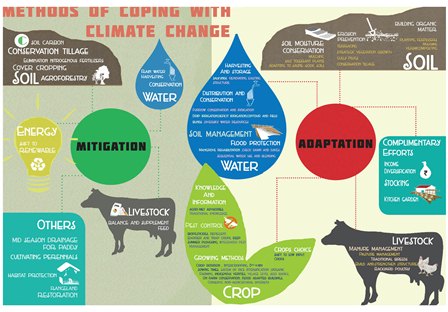A Gene Campaign Initiative. Review by S Krishna “Coping with Climate Change”, a book brought out by Gene Campaign and edited by Dr. Suman Sahai fills a gap beautifully. Painstakingly researched by its team of scientists and field workers, it focuses on the impact of climate change in India, but puts it in a global perspective.
The book covers the impact of climate change on everything: on the forests, the rivers, the seas, the mountains, the soil, the air, even its impact on society. It highlights the adverse effect that climate change has, and will continue having, on matters as diverse as food availability, the extinction of species, the increase in extreme weather conditions affecting human health, the rise of new and virulent pathogens. For an average reader, the term climate change is all about the weather: unseasonal rains, extended heat or cold waves, spikes in temperature. For the more interested reader, it is about global warming and carbon emissions and alternative energy sources. The buzz words are ‘sustainable development’, ‘green energy’ ‘renewable energy’ and so on. But climate change is not just about the weather or energy. It is actually about the survival of life as we know it today. Unfortunately, that point is not being emphasised in any discussion, policy initiatives or conventional understanding. It is not being taught in schools to the very children who are, hopefully, to inherit this earth. That may be because most writings on these matters are as yet, research papers or academic writings which don’t lend themselves to popular reading, and nothing at all has been written for children.
For an average reader, the term climate change is all about the weather: unseasonal rains, extended heat or cold waves, spikes in temperature. For the more interested reader, it is about global warming and carbon emissions and alternative energy sources. The buzz words are ‘sustainable development’, ‘green energy’ ‘renewable energy’ and so on. But climate change is not just about the weather or energy. It is actually about the survival of life as we know it today. Unfortunately, that point is not being emphasised in any discussion, policy initiatives or conventional understanding. It is not being taught in schools to the very children who are, hopefully, to inherit this earth. That may be because most writings on these matters are as yet, research papers or academic writings which don’t lend themselves to popular reading, and nothing at all has been written for children.
“Coping with Climate Change”, a book brought out by Gene Campaign and edited by Dr. Suman Sahai fills this gap beautifully. Painstakingly researched by its team of scientists and field workers, it focuses on the impact of climate change in India, but puts it in a global perspective.
The book covers the impact of climate change on everything: on the forests, the rivers, the seas, the mountains, the soil, the air, even its impact on society. It highlights the adverse effect that climate change has, and will continue having, on matters as diverse as food availability, the extinction of species, the increase in extreme weather conditions affecting human health, the rise of new and virulent pathogens.
Take the consequences of climate change on water, something that we understand straight away. Normally we take that to mean good or bad monsoons, or unseasonal rains, something that we are now witnessing ourselves. But climate change impacts the very source and nature of water: our glaciers are shrinking, our rain fed rivers are drying out, the ground water is being pumped out much faster than ever before and the recharge isn’t happening and the sea levels are rising eating into fresh water estuaries and coastal river systems. Fish habitats are shifting and because of the warming of the Indian Ocean, the oil sardine has already shifted north and east of its original boundaries. This affects the livelihood of agriculturists and the entire coastal population. It affects the type and quantity of food that is being produced. Rise in the sea levels will inundate large areas of coastal and the mangroves which sustain and feed lakhs of people. And if that wasn’t scary enough with the increase in people worldwide the demand for water is increasing. What will be the outcome of water wars that are being predicted, is easy enough to understand.
The book shows how the profile of diseases and pest that attack plants and animals are likely to change when the climate changes. For humans, insect borne diseases like malaria, dengue and chikunguniya will move to colder areas where they are not seen today. Scientists are predicting increased health risks with more serious and frequent episodes of diarrhea and cholera.
But it is not a doomsday book. It offers solutions too, as its title suggests, Coping with Climate Change. From simple easy to do local interventions to global policy matters, there are suggestions galore. Simple solutions on water conservation, coping strategies to deal with climate change on agriculture, establishment of farmer field schools, national grid of grain storages and so on.
The book is glossy, with lots of lovely pictures and the text is in an easy to read and attractive format. The main points are highlighted so that even a glance can familiarize the reader with the core issues. And yet, it is a comprehensive, detailed book which discusses in depth, all possible aspects on the subject. It looks like a coffee table book and I would certainly recommend using it as one!
This is a book which should be read by anyone interested in the future of our own survival as a species and a reference book for all schools. After all the children should be made conscious about what we are doing to their inheritance!













